Digital Posters
Advanced Liver Imaging: Masses & Methods
ISMRM & SMRT Annual Meeting • 15-20 May 2021

| Concurrent 5 | 15:00 - 16:00 |
2103.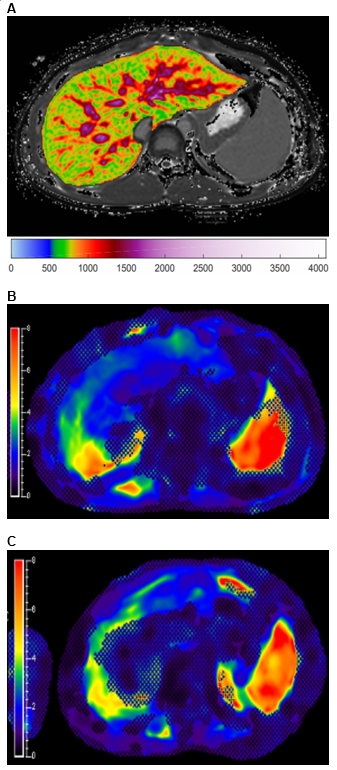 |
Longitudinal Change in Quantitative Magnetic Resonance Imaging Biomarkers in Pediatric Patients with Autoimmune Liver Disease
Neeraja Mahalingam1, Andrew Trout2,3,4, Deep Gandhi1, Ruchi Singh5,6, Alexander Miethke5,6, and Jonathan Dillman2,3,5
1Imaging Research Center, Cincinnati Children's Hospital Medical Center, Cincinnati, OH, United States, 2Department of Radiology, Cincinnati Children's Hospital Medical Center, Cincinnati, OH, United States, 3Department of Radiology, University of Cincinnati College of Medicine, Cincinnati, OH, United States, 4Department of Pediatrics, University of Cincinnati College of Medicine, Cincinnati, OH, United States, 5Center for Autoimmune Liver Disease, Cincinnati Children's Hospital Medical Center, Cincinnati, OH, United States, 6Division of Gastroenterology, Hepatology, and Nutrition, Cincinnati Children's Hospital Medical Center, Cincinnati, OH, United States
Changes over time in liver and spleen T1 relaxation and MR elastography (MRE) measurements in children with autoimmune liver disease (AILD) have not been extensively studied as markers of disease. Iron (T2*)-corrected T1 (cT1) mapping and MRE were performed in 67 pediatric/young adult patients at baseline, 12, and 24 months. One-way ANOVA (mixed model) tests identified no statically significant changes in liver cT1 and liver and spleen stiffness over time but near-significant trends were identified. Further studies with larger sample sizes are needed to expand upon these preliminary results and define the roles of cT1 and MRE in clinical practice.
|
|||
2104.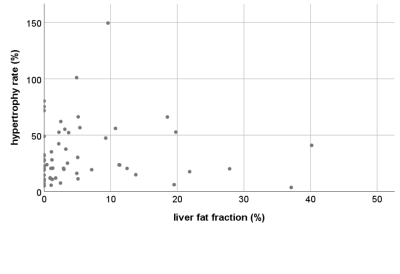 |
MRI-based quantitation of liver fat fraction does not predict the hypertrophy rate in patients with colorectal liver metastases undergoing PVE
Lea Hitpass1, Paul Felix Sieben1, Vanessa Raaff1, Philipp Bruners1, Christiane K. Kuhl1, and Alexandra Barabasch1
1Department of Diagnostic and Interventional Radiology, RWTH Aachen University Hospital, Aachen, Germany
There is a substantial clinical need to identify patients who benefit from PVE procedure before undergoing major liver surgery. Elevated liver fat fraction is a frequent finding on pre-procedural MRI based on increasing rates of (non-) alcoholic fatty liver disease as well as chemotherapy-associated steato-hepatitis. Therefore, it was this studys aim to investigate the correlation of MRI-based liver fat fraction on hypertrophy rates after PVE.Including patients with colorectal liver metastases undergoing a single type of portal vein occlusion only there was no correlation found indicating that MRI-based high liver fat fraction should not discourage to perform PVE.
|
|||
2105.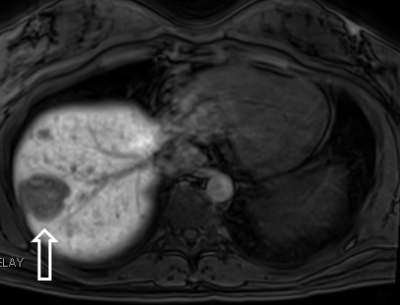 |
Hepatocellular Adenoma: Radiology-Pathology Subtype Associations with Hepatobiliary Phase MRI
Alix C Hopp1, Carolyn Mead-Harvey2, and Alvin C Silva1
1Radiology, Mayo Clinic Arizona, Phoenix, AZ, United States, 2Mayo Clinic Arizona, Phoenix, AZ, United States
Hepatocellular adenoma (HCA) is an uncommon benign tumor with risk for tumoral hemorrhage and malignant transformation. At least four HCA subtypes have been described: Inflammatory (I-HCA); hepatocyte nuclear factor 1-α mutated (H-HCA); β-catenin (B-HCA); and unclassified (U-HCA). I-HCA has the highest risk for tumoral hemorrhage, whereas B-HCA is the most likely to undergo malignant transformation. Clinical management differs for HCA subtypes, based on their different level of risk for complications. This study examines the image findings of pathologically proven HCAs from our institution on gadoxetic acid-enhanced MRI, in order to describe association between MRI image findings with HCA subtypes.
|
|||
2106.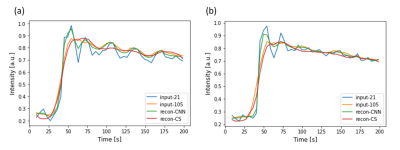 |
Acquisition of High-resolution Time Intensity Curves Using a Deep Learning Reconstruction for Dynamic Contrast Enhanced MRI
Hideaki Kutsuna1, Hideki Ota2,3, Yoshimori Kassai4, Hidenori Takeshima5, Tatsuo Nagasaka6, Takashi Nishina7, Yoshiaki Morita3, and Kei Takase3,8
1MRI Systems Development Department, Canon Medical Systems Corporation, Kanagawa, Japan, 2Department of Advanced MRI Collaboration Research, Tohoku University Graduate School of Medicine, Miyagi, Japan, 3Department of Diagnostic Radiology, Tohoku University Hospital, Miyagi, Japan, 4CT-MR Solution Planning Department, Canon Medical Systems Corporation, Tochigi, Japan, 5Advanced Technology Research Department, Research and Development Center, Canon Medical Systems Corporation, Kanagawa, Japan, 6Department of Radiological Technology, Tohoku University Hospital, Miyagi, Japan, 7MRI Sales Department, Canon Medical Systems Corporation, Miyagi, Japan, 8Department of Diagnostic Radiology, Tohoku University Graduate School of Medicine, Miyagi, Japan The purpose is to provide improved time intensity curves (TICs) of dynamic contrast enhanced MRI. In this work, a method based on convolutional neural network (CNN) was compared with a conventional method based on compressed sensing (CS). While both of the methods used radial sampling for free-breathing acquisitions, reconstruction strategies were different. The experimental results showed that, in comparison with the images reconstructed with CS, the images reconstructed with CNN exhibited higher temporal resolution in the TICs without losing spatial detail. |
|||
2107.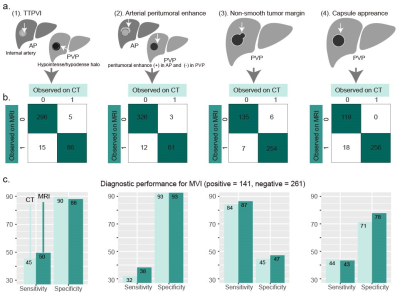 |
Comparison of MRI and CT for Prediction of Microvascular Invasion in Solitary Hepatocellular Carcinoma: Which Imaging Modality Is Better?
Xiang-Pan Meng1, Yuan-Cheng Wang1, and Shenghong Ju1
1Radiology, Zhongda Hospital, Medical School of Southeast University, Nanjing, China
Given the fundamental role of imaging in predicting MVI, it is important to understand relative ability of different imaging modalities. However, whether CT and MRI have a comparable predictive performance for MVI is unknown. This study aimed to compare the performance of CT and MRI for prediction of MVI in solitary HCC and investigate added value of radiomics analysis for MVI prediction.
|
|||
2108.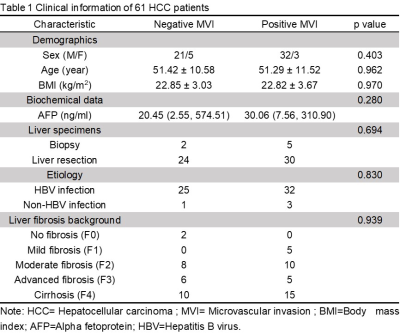 |
MR Elastography-based Shear Strain Mapping for Assessment of Microvascular Invasion in Hepatocellular Carcinoma
Bing Hu1, Ziying Yin2, Mengsi Li1, Ying Deng1, Sichi Kuang1, Jun Chen2, Linqi Zhang1, Meng Yin2, Kevin J. Glaser2, Richard L. Ehman2, and Jin Wang1
1Radiology, The Third Affiliated Hospital of Sun Yat-Sen University, Guangzhou, China, 2Radiology, Mayo Clinic, Rochester, MN, United States
The presence of microvascular invastion (MVI) at histopathology is an important predictive factor in managing hepatocellular carcinoma (HCC). We evaluated the potential of MRE-based shear strain mapping to assess adhesion characteristics at tumor boundaries and to non-invasively predict the presence of MVI. We retrospectively calculated maps displaying octahedral shear strain in exams of 61 HCC patients who underwent 3D multi-frequency MRE examinations. Results demonstrated that the prevalence of adherent tumor-liver parenchyma interface in positive MVI groups was significantly higher than negative groups. The results provide evidence that MRE-based shear strain mapping is helpful for non-invasive prediction of MVI in HCC.
|
|||
 |
2109.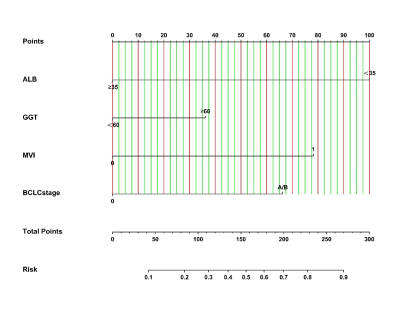 |
A nomogram based on Gd-EOB-DTPA-enhanced MRI to predict early recurrence of hepatocellular carcinoma after curative resection
Meng Yan1, Xinming Li1, Zhijun Geng2, Zhendong Qi1, Yingjie Mei3, and Xianyue Quan1
1Department of Radiology, Zhujiang Hospital, Southern Medical University, Guangzhou, China, 2Department of Medical Imaging,Sun Yat-sen University Cancer Center, Guangzhou, China, 3Philips Healthcare, Guangzhou, China
Hepatic resection is the optimal treatment for patients with hepatocellular carcinoma (HCC) in the very early or early stage [Barcelona Clinic Liver Cancer (BCLC)0/A]. However, recurrence within 2 years occurs in 30%–50% of patients; hence, HCC is the major cause of mortality. This study aimed to develop and validate a clinical model to predict the early recurrence of HCC after curative resection. The proposed nomogram provided better discrimination than the BCLC stage and AJCC-TNM (eight edition).
|
||
2110.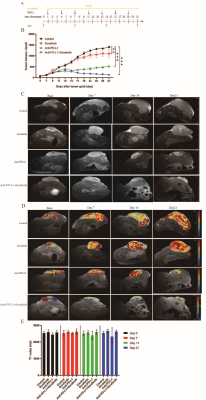 |
Correlation of functional MRI with changes in tumor microenvironment following sorafenib and immunotherapy in hepatocellular carcinoma
Yanqiao Ren1, Jingjie Yan2, Lian Yang1, Qingjia Bao3, Chaoyang Liu3, and Chuansheng Zheng1
1Department of Radiology, Union Hospital, Tongji Medical College, Huazhong University of Science and Technology, Wuhan 430022, China, Wuhan, China, 2Wuhan National Laboratory for Optoelectronics, Huazhong University of Science and Technology, Wuhan, 430074, China., Wuhan, China, 3State Key Laboratory of Magnetic Resonance and Atomic and Molecular Physics, Wuhan Institute of Physics and Mathmatics, Innovation Academy for Precision Measurement Science and Technology, 430071Wuhan, China, Wuhan, China
Molecular and pathological characteristics of the tumor microenvironment have been shown to cause tumor heterogeneity and variability in therapeutic responses. We used functional MRI to evaluate the changes in tumor microenvironment after treatment with sorafenib and anti-PD-L1 antibody for hepatocellular carcinoma (HCC). The results indicated that DWI-MRI and MRS could dynamically assess microenvironmental changes including tumor necrosis and tumor hypoxia. The findings of this study are conducive to the establishment of an accurate correlation between imaging features-microenvironment characteristics-tumor anti-vascular treatment and immunotherapy, and the realization of scientific and precise individualized treatment of HCC.
|
|||
2111.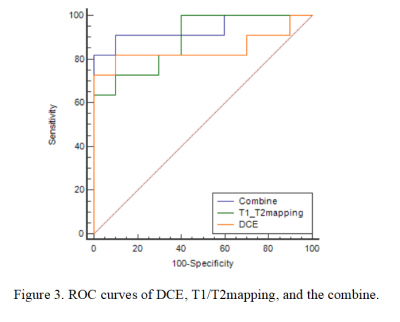 |
Dynamic contrast enhanced imaging (DCE-MRI) combined with T1 and T2 mapping for differentiation between HCC and HM
Lili Fan1, Ailian Liu1, Jiazheng Wang2, Liangjie Lin2, Lihua Chen1, Qingwei Song1, Renwang Pu1, Ying Zhao1, Tao Lin1, and Xue Ren1
1The First Affiliated Hospital of Dalian Medical University, Dalian, China, 2Philips Healthcare, Beijing, China
Liver cancer and liver metastases are the most common liver malignancies. The accurate diagnosis of hepatocellular carcinoma (HCC) and hepatic metastasis (HM) is of great significance to the choice of treatment options. We aimed to explore the value of dynamic contrast enhanced magnetic resonance imaging (DCE-MRI) combined with T1 and T2 mapping to distinguish HCC from HM. Results showed that DCE combined with T1 and T2 mapping had the highest efficacy (AUC: 0.936; sensitivity: 81.8%; specificity: 100%).
|
|||
2112.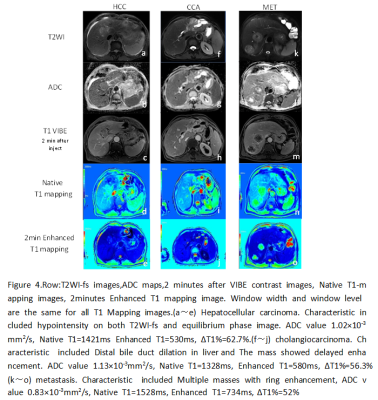 |
3D Dual Flip Angle (DFA) T1 mapping at 3T for focal liver lesions: comparison with diffusion-weighted imaging
Fei Wang1, Juan Zhu1, Yupei Zhang1, and Mengxiao Liu2
1Anqing municipal hospital, Anqing, China, 2MR scientific Marketing, Diagnostic Imaging, Siemens Healthcare Ltd, Shanghai, China
The diagnostic value of dual-flip angle (DFA) T1 mapping and DWI imaging in the diagnosis of benign and malignant focal liver lesions (FLLs) were compared.T1 mapping includes Native T1,Enhanced T1 in the equilibrium period of 2 minutes after Gd-DTPA enhancement,and T1 enhancement rate ΔT1%.In T1 mapping, the enhanced T1 value and ΔT1% have diagnostic sensitivity and specificity similar with DWI.The Native T1 value is superior to DWI in the differential diagnosis of liver cysts and hemangioma.T1 mapping has a promising future as a non invasive alternative method for biopsy identification of benign and malignant FLLs.
|
|||
2113.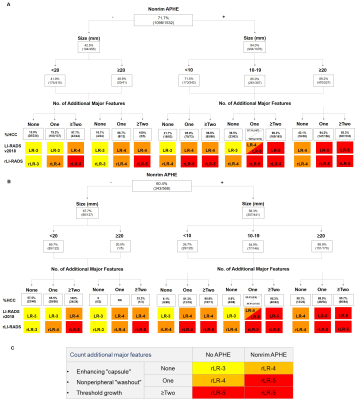 |
Data-driven modification of the LI-RADS major feature system: toward better sensitivity and simplicity
Hanyu Jiang1,2, Bin Song1, Yun Qin1, Yi Wei1, Kyle J. Lafata2,3, Meghana Konanur2, Matthew DF McInnes4,5, and Mustafa R. Bashir2,6,7
1Radiology, West China Hospital, Sichuan University, Chengdu, China, 2Radiology, Duke University Medical Center, Durham, NC, United States, 3Radiation Oncology, Duke University School of Medicine, Durham, NC, United States, 4Radiology, University of Ottawa, Ottawa, ON, Canada, 5Epidemiology, University of Ottawa, Ottawa, ON, Canada, 6Center for Advanced Magnetic Resonance in Medicine, Duke University Medical Center, Durham, NC, United States, 7Division of Gastroenterology, Department of Medicine, Duke University Medical Center, Durham, NC, United States
We aimed to propose a revised LI-RADS (rLI-RADS) for hepatocellular carcinoma (HCC) based on the LI-RADS version 2018 (v2018) major feature system on gadoxetate disodium (EOB)-enhanced MRI. We retrieved 224 consecutive at-risk patients with 742 LR-3 to LR-5 hepatic observations from a prospectively-collected database. In the training set, LI-RADS v2018 major features evaluated by three independent radiologists were used to develop rLI-RADS according to the likelihood of HCC. Compared with LI-RADS v2018, rLI-RADS was completely data-driven, remarkably simpler, and demonstrated significantly optimized diagnostic sensitivity and accuracy while maintaining reasonable specificity for HCC.
|
|||
2114.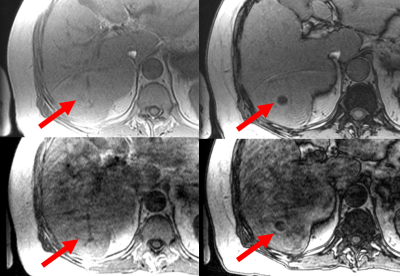 |
Comparing dedicated 2D-GRE to 3D-SPGR Dixon in- and opposed-phase imaging for the detection of hepatic intralesional fat or iron.
Bradley C Monteforte1, Ali Agely1, Manoj Mathew1, Pejman Ghanouni1, and Ryan L Brunsing1
1Radiology, Stanford University, Palo Alto, CA, United States
In- and opposed-phase imaging has become integral in liver MR imaging due to its ability to identify intravoxel fat or iron, important ancillary features in lesion characterization, particularly during hepatocellular carcinoma surveillance. Potentially, these features can be assessed through images acquired from dynamic contrast-enhanced imaging, rather than separate sequence acquisitions, decreasing scan times. Two blinded radiologists retrospectively reviewed MR liver examinations comparing in- and opposed-phase 2D-GRE imaging to 3D-SPGR Dixon imaging for the assessment of intralesional fat or iron. We found that there is no difference in fat or iron detection performance between dedicated 2D-GRE and 3D-SPGR Dixon sequences.
|
|||
2115.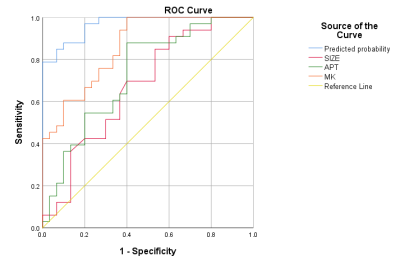 |
Application of APT and DKI in predicting the postoperative liver decompensation and recurrence of early HCC after TACE treatment
Cai ming xi1, Han dong ming1, and Wang kai yu2
1The First Affiliated Hospital of Xinxiang Medical University, Xinxiang, China, 2GE Healthcare, MR Research China, Beijing, China
In this study we assessed the feasibility of quantitative parameters derived from amide proton transfer (APT) and diffusion kurtosis imaging (DKI) in predicting the response to transcatheter arterial chemoembolization (TACE) treatment for hypervascular hepatocellular carcinoma (HCC). The combination model of quantitative parameters of APT and DKI showed good diagnostic performance in predicting the recurrence and postoperative liver decompensation. Therefore, APT and DKI can be used as potential imaging biomarkers to predict the effect of early-stage HCC after TACE treatment.
|
|||
2116. |
Contrast-enhanced MRI radiomics for predicting therapeutic response to transcatheter arterial chemoembolization in HCC
Ying Zhao1, Ailian Liu1, Tao Lin1, Qingwei Song1, Yu Yao2,3, Han Wen2,3, Xin Li4, Yan Guo4, and Tingfan Wu4
1The First Affiliated Hospital of Dalian Medical University, Dalian, China, 2Chengdu Institute of Computer Application, Chinese Academy of Sciences, Chengdu, China, 3University of Chinese Academy of Sciences, Beijing, China, 4GE Healthcare (China), ShangHai, China
In the present study, contrast-enhanced MRI radiomics was demonstrated to be capable to predict therapeutic response in hepatocellular carcinoma treated with transcatheter arterial chemoembolization, which will provide some guidance for treatment decisions.
|
|||
2117.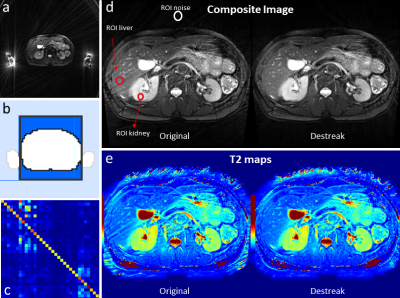 |
Accelerated Radial Turbo-Spin-Echo Sequence for Free-Breathing Abdominal T2 Mapping
Fei Han1 and Vibhas Deshpande2
1US MR R&D, Siemens Medical Solutions, USA, Los Angeles, CA, United States, 2US MR R&D, Siemens Medical Solutions, USA, Austin, TX, United States
This study proposes a comprehensive strategy to accelerate a Radial-TSE acquisition for qualitative T2-weighted imaging and quantitative T2 mapping for body applications. A fast k-space calibration method, a radial de-streaking method based on geometric coil mixing and accelerated acquisition using multiple gradient-echo radial readout between 180° refocusing pulses were implemented. Preliminary validation in phantom and in-vivo experiments shows that the proposed method reduces the scan time of Radial-TSE by half without noticeable loss of image quality and quantification accuracy. The proposed method may allow more efficient acquisition and improve the clinical applicability of free-breathing abdominal T2 quantitative imaging.
|
|||
2118.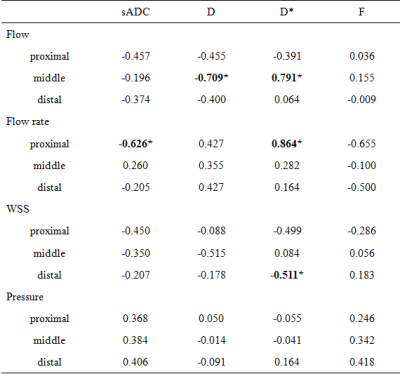 |
Comparison analysis of IVIM and 4D flow-MRI in patients with liver cirrhosis
Mengting Hu1, Nan Wang1, Ailian Liu1, Qingwei Song1, Renwang Pu1, Lihua Chen1, Jiazheng Wang2, and Zhiwei Shen2
1The First Affiliated Hospital of Dalian Medical University, Dalian, China, 2Philips Healthcare, Dalian, China
The occurrence and development of liver cirrhosis is accompanied by changes in portal vein blood flow and intrahepatic blood flow, which may eventually lead to liver implantation [1]. Liver-lobe-based IVIM-derived parameters can be associated with cirrhosis [2]. 4D flow-MRI could scope the portal vein blood flow [3]. In this study, we explored the correlation between the perfusion paraments and quantitative values of blood flow in patients with liver cirrhosis using IVIM and 4D flow-MRI, investigating the potential connections between portal vein flow changes and liver cirrhosis.
|
|||
2119. |
Noninvasive Diagnosis of Portal Hypertension and Screening Varices with 4D Flow MRI: A Pilot Study
Jiachen Ji1, Changchun Liu2, Yunduo Li1, Mingzhu Fu1, Jinghui Dong2, Jianming Cai2, Chunsheng Chi3, Bo Jin3, Wen Shen4, Xiaolong Qi5, and Rui Li1
1Center for Biomedical Imaging Research, Department of Biomedical Engineering, Tsinghua University, Beijing, China, 2Department of Radiology, The Fifth Medical Centre of Chinese PLA General Hospital, Beijing, China, Beijing, China, 3First Liver Cirrhosis Diagnosis and Treatment Center, The Fifth Medical Center of Chinese PLA General Hospital, Beijing, China, Beijing, China, 4Department of Radiology, First Center Hospital of Tianjin, Tianjin, China, Tianjin, China, 5CHESS Center, Institute of Portal Hypertension, The First Hospital of Lanzhou University, Lanzhou, China, Lanzhou, China
Portal hypertension (PH) is a severe liver disease which could lead to gastroesophageal varices. Noninvasive methods to diagnose PH and to evaluate the risk of variceal bleeding are needed. 4D Flow MRI is an advanced technique which could provide visualization and quantification of blood flow. In the study, we identified the reproducibility of the processing and quantifying procedure of 4D Flow data and discovered the significant hemodynamic differences in portal vein between PH patients and controls using 4D Flow MRI. Additionally, we tested the performance of 4D Flow MRI in diagnosing PH and stratifying the risk of variceal bleeding.
|
|||
2120.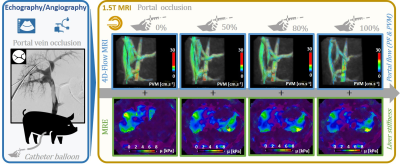 |
Influence of portal vein occlusion on portal flow and liver elasticity in an animal model
Simon Chatelin1, Raoul Pop2,3, Céline Giraudeau2, Khalid Ambarki4, Ning Jin5, François Séverac1,6, Elodie Breton1, and Jonathan Vappou1
1ICube, UMR 7357 CNRS, University of Strasbourg, Strasbourg, France, 2IHU-Strasbourg, Institute of image-guided surgery, Strasbourg, France, 3Interventional Neuroradiology Department, University Hospitals of Strasbourg, Strasbourg, France, 4Siemens Healthcare SAS, Saint Denis, France, 5Siemens Medical Solutions USA, Inc., Chicago, IL, United States, 6Public Healthcare Department, University Hospitals Strasbourg, Strasbourg, France
Hepatic fibrosis causes an increase in the liver stiffness, a parameter measured by elastography and widely used as diagnosis method. This study aims at determining the extent to which a portal occlusion due to concomitant portal vein thrombosis can also affect these mechanical properties. Portal vein occlusion was generated by progressive inflations of a balloon catheter in the portal vein of four swines. The portal flow and liver stiffness were investigated using 4D-flow MRI and MR-Elastography. This vascular mechanism is shown to be sufficient to attenuate the increase in stiffness due to moderate fibrosis and may lead to false-negative diagnosis.
|
|||
2121.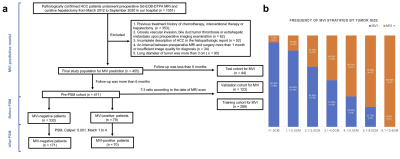 |
Microvascular Invasion has no Independent Effect on Recurrence in Small Hepatocellular Carcinoma: A Propensity Score Matching Analysis
Huan-Huan Chong1,2, Pei-Yun Zhou3,4, Chun Yang2, and Meng-Su Zeng1,2,5
1Shanghai Institute of Medical Imaging, Shanghai, China, 2Department of Radiology, Zhongshan Hospital, Fudan University, Shanghai, China, 3Department of Liver Surgery, Liver Cancer Institute, Zhongshan Hospital, Fudan University, Shanghai, China, 4Key Laboratory of Carcinogenesis and Cancer Invasion of Ministry of Education, Shanghai, China, 5Department of Medical Imaging, Shanghai Medical College, Fudan University, Shanghai, China
Whether microvascular invasion (MVI) is a prognosis factor for small hepatocellular carcinoma (sHCC) is controversial, a preoperatively predictive model based on gadoxetate disodium (Gd-EOB-DTPA) MRI is clinical needed for MVI in sHCC.We concluded that alpha-fetoprotein>20 ng/mL, non-smooth margin, incomplete or absent capsule, peritumoral enhancement and larger tumor size were independent risk factors for MVI in patients with sHCC ≤3 cm. Although MVI independently impaired RFS before propensity score matching (PSM), it was ultimately identified as a potential but not an independent risk factor for recurrence in sHCC patients after PSM balancing the confounder — tumor size.
|
The International Society for Magnetic Resonance in Medicine is accredited by the Accreditation Council for Continuing Medical Education to provide continuing medical education for physicians.